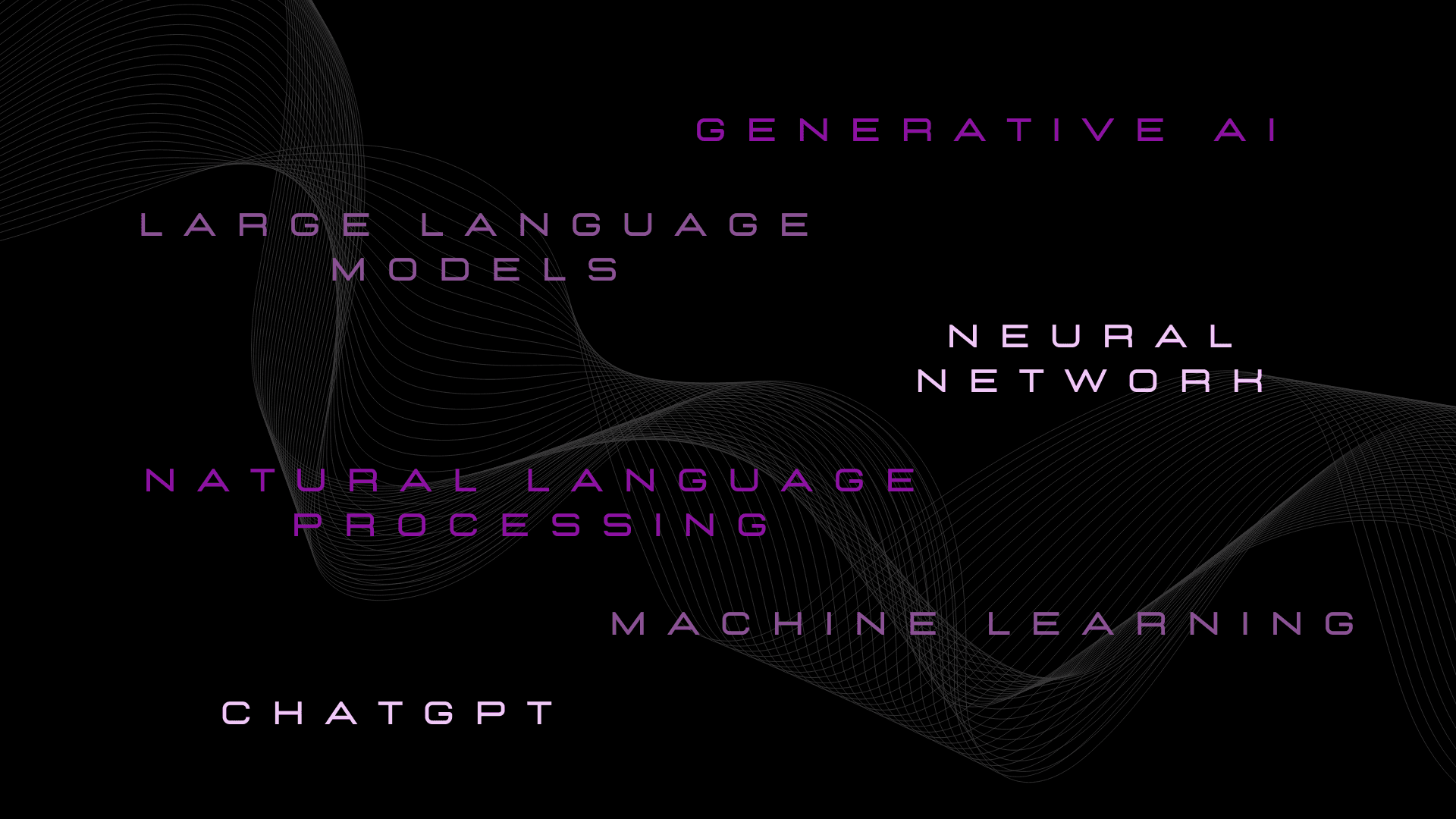Every day, we hear buzzwords like ‘generative AI', 'machine learning', and 'LLM', but what do they truly mean? As AI shapes industries from finance to healthcare, understanding its key terms is as crucial as once grasping the internet's basics was in the late 90s and early 2000s. This isn't merely about tech literacy; it's about staying ahead in an evolving business world. If the jargon seems daunting, don't worry. This glossary is your guide, simplifying complex AI concepts relevant to your profession.
Basic AI Concepts
Artificial Intelligence (AI): This is where it all begins. AI is a vast field dedicated to building smart machines capable of performing tasks that typically require human intelligence. Think of it as the grand umbrella under which various subfields, including robotics, natural language processing, and machine learning, reside.
Machine Learning (ML): Ever heard the phrase, "practice makes perfect"? Machine learning is somewhat based on that principle. Instead of programming machines with specific instructions for every task, ML allows machines to learn and improve from experience, i.e., data. It's like teaching computers to learn from trial and error.
Deep Learning: Picture a vast web of interconnected nodes, much like our brain's network of neurons. That's a simplistic view of deep learning. It uses multi-layered neural networks to process data in complex ways, enabling machines to make accurate decisions without human intervention. It's the powerhouse behind innovations like image and speech recognition.
Key Technologies and Models
Neural Network: Think of these as the brainpower behind most AI systems. Just like our brain has neurons that process and transmit information, neural networks have virtual neurons (nodes) that process data. They're especially good at spotting patterns, which is why they're used for tasks like image recognition. Imagine teaching a computer to recognize a cat by showing it thousands of cat pictures - that's a neural network in action!
Natural Language Processing (NLP): Ever chatted with Siri, Alexa, or any chatbot? That's NLP at work! It's all about teaching machines to understand and respond to human language. This doesn't just mean recognizing words, but also understanding context, sarcasm, emotions, and much more. It's like teaching a computer to read between the lines.
Language Models (LM): These models are trained to understand and generate text based on vast amounts of data they're fed. They underpin many applications that process or generate text, from search engines to chatbots.
LLM (Large Language Models): As the name suggests, these are expansive versions of standard language models. Their size allows them to have deep comprehension and to produce sophisticated text outputs. Models like GPT-3 and GPT-4 belong to this category.
Generative AI: This refers to a category of AI models that can generate new, previously unseen content. The "generative" part means they can produce (or "generate") outputs on their own. This includes generating texts, images, music, and more. Large Language Models (LLMs) are a type of generative AI.
AI Tools
AI Chatbots
ChatGPT: Developed by OpenAI, ChatGPT is an instance of LLMs tailored for conversations. It's not only adept at understanding and producing human-like dialogue but also capable of answering queries, generating creative content, assisting in research, and more. This versatility makes it a favored choice for chatbot applications and diverse interactive scenarios in the digital realm.
Bard: Created by Google in response to OpenAI's ChatGPT, Bard is an experimental conversational AI chatbot powered by PaLM 2. While it offers functionalities similar to ChatGPT, such as coding, solving math problems, and assisting with writing, Bard stands apart by sourcing its information directly from the web and providing relevant images in its answers.
Bing AI: Microsoft's Bing AI integrates the power of GPT-4, offering a unique blend of conversational interaction and real-time internet search. While it mirrors the chat capabilities of ChatGPT, its distinguishing feature lies in offering updated current event information and versatile image generation and analysis. In essence, Bing AI is Microsoft's endeavor to merge the world of traditional search engines with the nuances of AI chatbots.
AI Image generation
DALL-E 2: Developed by OpenAI, DALL-E 2 is a text-to-image model designed to transform natural language descriptions into detailed digital visuals. Announced in April 2022, this model excels at generating realistic, high-resolution images by seamlessly combining concepts, attributes, and styles. It's accessible exclusively via OpenAI's website.
Midjourney: Similar to DALL-E 2, Midjourney translates natural language prompts into a diverse range of art styles, from abstract to lifelike visuals. It is available through Discord and presents an ideal solution for those seeking quick art generation from textual descriptions.
Open Source
Llama 2: Resulting from a rare collaboration between Meta and Microsoft, Llama 2 is an open-source large language model. Llama 2 is a "foundational model", which means it's designed to be versatile across a wide array of tasks, unlike specialized tools like ChatGPT and Bard, which are "fine-tuned" to excel in specific domains like conversational AI. Though not as readily accessible as ChatGPT, enthusiasts can download Llama 2 for local use or tap into it via a Hugging Face cloud-hosted instance.
Things to Know
Prompting: In the context of AI, especially language models, prompting refers to the process of providing an input or cue to the model in order to generate a specific output. The model's response is influenced by how the prompt is structured. For instance, giving a prompt like "Translate the following English text to French:" would guide the model to perform a translation task.
Fine-Tuning: The process of making minor adjustments to an AI model after it has been pre-trained. This allows the model to specialize in a specific task or better understand a niche dataset.
Bias in AI: This occurs when an AI system shows an unintended preference for one group or category over another, typically due to the nature of its training data. It can lead to unfair or inaccurate results.
Overfitting: This happens when an AI model is too finely tuned to its training data and ends up performing very well on that data but poorly on new, unseen data. Think of it like studying excessively for a specific set of questions and then performing poorly when presented with different questions on the same topic.
Hallucinations: In AI terminology, hallucinations refer to instances when a model generates information that isn't accurate or factual. This can happen due to various reasons such as biases in the training data, overfitting, or the model trying to make sense of ambiguous prompts. For AI models that generate text or images, it's essential to be aware of potential hallucinations and verify outputs against trusted sources.
Turing Test: Named after the British mathematician Alan Turing, this test challenges a machine's ability to display behavior indistinguishable from that of a human. If you can't tell whether you're talking to a machine or a human, then the machine has "passed" the Turing Test.
Conclusion
As we stride into a future where AI permeates almost every facet of our lives, it's more crucial than ever to have a grasp of its underlying concepts. From driving innovations in industries to making our daily tasks more efficient, AI is steadily becoming the bedrock of the next technological revolution. Don't be left in the dust by its rapid advancements; take the time to understand and embrace it. After all, knowledge is power, and in this case, it's the key to unlocking the vast potentials that AI promises. Whether you're a professional in tech, finance, health, or any other field, a basic understanding of AI can be your asset in the evolving landscape of tomorrow.


